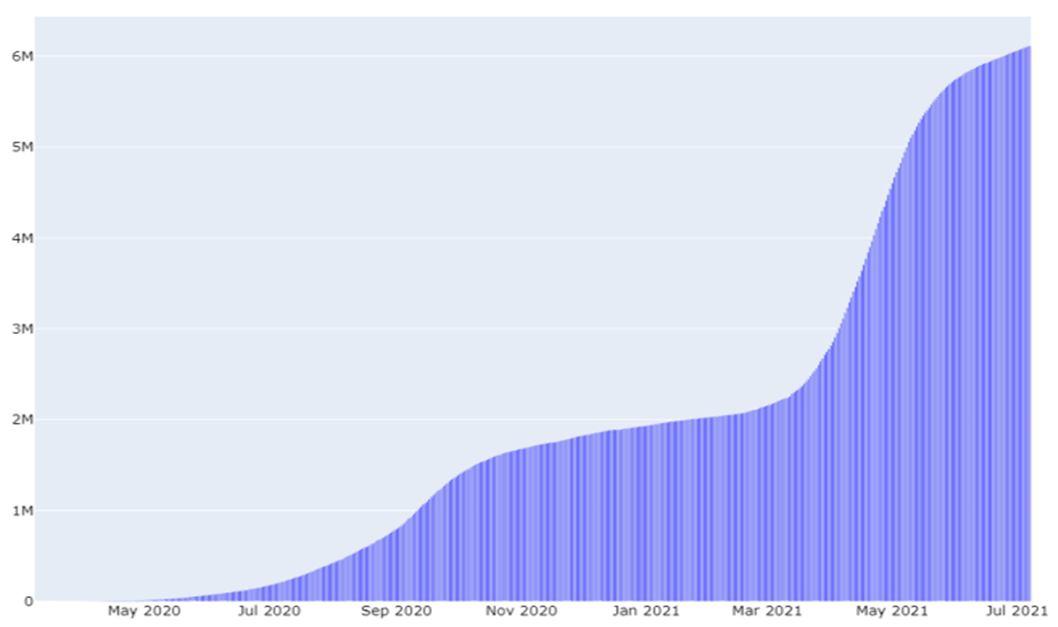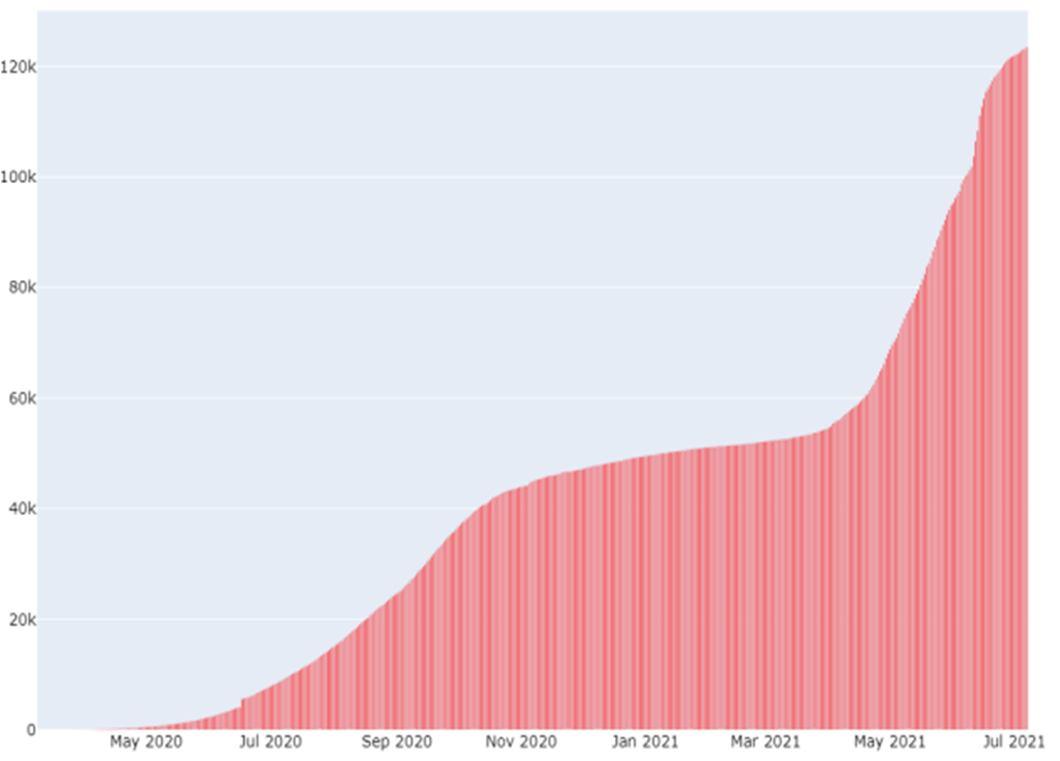
ISSN:


ISSN:
Abstract: The transmission of COVID 19 disease has shown a great impact on society. The whole world has been fighting this epidemic since late February 2020. The main objective of this project is to predict the spread and end of the COVID 19 disease. Because of the COVID-19 outbreak, the world's economy has been affected so far and an accurate prognosis of its epidemic is significant. Prediction for the end of this disease is not an easy task as it requires plenty of data and also various parameters involved in the prediction. This project proposes certain machine learning techniques and ARIMA models with numerical approximations from the dataset provided we forecast the number of reported cases and disease transmission.
Keywords: ARIMA Model, Visualization, Seasonal Decomposition, SARIMA Model

COVID 19 has affected every country around the world. The number of infected and dead people due to this disease has been raised. Prediction models contribute knowledge of the disease and its prevalence. These strategies examine past occurrences and scenarios to produce the best predictions for the future. These forecasts may aid people in preparing for potential outcomes[1][2]. They play a major role in getting accurate predictions. These models can either be predicted by mathematical models or by machine learning techniques. Data should be collected from different sources in large quantities to prepare an accurate model. Various parameters such as environmental factors, quarantine period, disease spreading rate, immunity levels of the person, person’s past health issues, etc., are taken before forecasting the pandemic[5]. People throughout the world are researching many different ways to end this disease and are also predicting models using machine learning techniques[6]. The model is built to forecast the number of confirmed cases, recovered cases, and death cases based on the data available. For the prediction model, the time series forecasting method is applied.
Many mathematical models are used to predict the graph trend, but we used the ARIMA model for predicting the virus graph for the coming days. The ARIMA model is applied to forecast the data, which is high in terms of accuracy. ARIMA (Auto Regressive Integrated Moving Average) model is a forecasting algorithm, the information contained in the past values of the time series can be utilized to forecast future values on its own. It is a type of model that describes a time series based on its previous values. As a result, that equation can be used to predict future values. This model is used to gain a better understanding of the data and to forecast future points in the series. It is applied to time series forecasting and provides complementary methods to the problem. Prediction models contribute knowledge of the disease and its prevalence. These strategies examine past occurrences and scenarios to produce the best predictions for the future. These forecasts may aid people in preparing for potential outcomes. They play a major role in getting accurate predictions. These models can either be predicted by mathematical models or by machine learning techniques. Data should be collected from different sources in large quantities to prepare an accurate model. Various parameters such as environmental factors, quarantine period, disease spreading rate, immunity levels of the person, person’s past health issues, etc., are taken before forecasting the pandemic.
1) AR Model: It is a statistical model which predicts future value based on its past values is called lags. The model that depends only on one lag in the past is given below:
This model is called the long memory model. If the recursion in time goes back until the beginning of the series, those are called long memory models.

Sai Praveen1, Ravi Kant Kumar2
Department of Computer Science and Engineering, SRM University AP, Andhra Pradesh, India
ISSN:
2) MA MODEL (Moving Average Model): It
9653;
www.ijraset.com
a model which predicts the future based on past errors called errors. It depends only on the lag of error
the past.
model
lag in the past:
These are called short memory models. There is no effect on the present predicted value if there are any big errors long enough ago.
Arima Model: Auto Regressive Integrated Moving Average Model ARIMA model is a forecasting algorithm, the information contained in the past values of the time series can be utilized to forecast future values on its own. It is a type of model that describes a time series based on its previous values. As a result, that equation can be used to predict future values.[3] This model is used to gain a better understanding of the data and to forecast future points in the series. It is applied to time series forecasting and provides complementary methods to the problem. An ARIMA model is characterized by 3 terms: ● p, d, and q.
1. p order of AR.
2. q order of MA.
3. d differencing we did for our time series stationary.
4. AR term It is based on past values.

5. MA term It is based on past errors.
The first step to build an ARIMA model is to make the time series stationary because ‘Auto Regressive’ in ARIMA means it is a linear regression model that uses its lags as predictors.[4] Linear regression models work best when the predictors are not correlated and are independent of each other.
What is p?
p is the order of the AR (Auto Regressive) term. It refers to the number of Y lags to be utilized as predictors.
What is q?
q is the order of the MA (Moving Average) term. It refers to the number of lagged forecast errors that should go into the ARIMA Model.
What is d?

The most common approach to make the series stationary is to differentiate it i.e, subtract the previous value from the current value depending on the complexity of the series, more than one differencing may be needed. The value of d is the minimum number of differences needed to make the series stationary. If the time series is stationary, then d = 0.

3) SARIMA Model: If a time series exhibits seasonal patterns, seasonal terms must be included, becoming SARIMA, short for ‘Seasonal ARIMA’.
4) Seasonal Order (P,Q,D,Seasonality)
The CSV file contains the number of confirmed, active, and recovered cases along with the number of deaths. The file was updated with figures on 5th, July 2021. The file can be downloaded from[9]. You can also get the total data on COVID 19 in India[8]. And data for the total world can be found on WorldOmeters[10].
ISSN: 2321 9653; IC





www.ijraset.com

ISSN: 2321



www.ijraset.com


ISSN: 2321 9653;




www.ijraset.com

(ADF
on its
International Journal for Research in Applied Science & Engineering Technology (IJRASET)

ISSN: 2321 9653; IC Value: 45.98; SJ Impact Factor: 7.538
Volume 10 Issue IX Sep 2022 Available at www.ijraset.com
To check stationarity we used the Dickey Fuller test. Dicker Fuller Test is a common statistical test used to test whether a given time series is stationary or not. Here, the p value is less than 0.05 so our data is stationary. P value > 0.05 , our data is not stationary. P value < 0.05 , our data is stationary[3][4].
Seasonal decomposition involves thinking of a series as a combination of level, trend, and seasonality.[4]
Figure 11: Analysis to summarise (or, occasionally,
elements: the linear trend, the periodic (seasonal) component,
the random residuals.
The coefficient correlation between two values in a time series is called the AutoCorrelation Function. We select the MA using AutoCorrelationFunction. Here are the best MA values 1 and 5[4].

Figure 12: the average relationship between the data points in a time series and the data points before them.


Partial autocorrelation is the summary of the relation between a value with value at previous time steps. We select AR with Partial autocorrelation.
©IJRASET:
ISSN: 2321 9653; IC Value: 45.98; SJ Impact Factor: 7.538 Volume 10 Issue IX Sep 2022 Available at www.ijraset.com

Figure
To find the d, we used ndiffs from Arima. Firstly, we should fit the training set with the SARIMAX model. Then we need to predict the test data. So, we used summary_frame for getting the data frame of predicted values.

In the above study, we have assessed the situation of Covid 19 in India. We have developed equations from March to June for the number of cases, deaths, and active cases. We then used the regression model to forecast the cases for upcoming days along with the accuracy percentage. The results are also provided in the above section. The project can be further developed by taking many other factors like vaccinated people, vaccination rate, variants and their spread rate, the measures taken like lockdown, etc. This mathematical model of forecasting cases for the future will surely prove to be helpful in the fight against the pandemic.

[1] Tiwari, Sunita, Sushil Kumar, and Kalpna Guleria. "Outbreak trends of coronavirus disease 2019 in India: a prediction." Disaster medicine and public health preparedness 14, no. 5 (2020): e33 e38.
[2] Jia, Lin, Kewen Li, Yu Jiang, and Xin Guo. "Prediction and analysis of coronavirus disease 2019." arXiv preprint arXiv:2003.05447 (2020).
[3] Benvenuto, Domenico, et al. "Application of the ARIMA model on the COVID 2019 epidemic dataset." Data in brief 29 (2020): 105340.
[4] Hillmer, Steven Craig, and George C. Tiao. "An ARIMA model based approach to seasonal adjustment." Journal of the American Statistical Association 77.377 (1982): 63 70.
[5] Zhong, Linhao, Lin Mu, Jing Li, Jiaying Wang, Zhe Yin, and Darong Liu. "Early prediction of the 2019 novel coronavirus outbreak in the mainland China based on simple mathematical model." Ieee Access 8 (2020): 51761 51769.
[6] Bentout, Soufiane, Abdennasser Chekroun, and Toshikazu Kuniya. "Parameter estimation and prediction for coronavirus disease outbreak 2019 (COVID 19) in Algeria." AIMS Public Health 7, no. 2 (2020): 306.
[7] Abdi, Milad. "Coronavirus disease 2019 (COVID 19) outbreak in Iran: Actions and problems." Infection Control & Hospital Epidemiology 41, no. 6 (2020): 754 755.
[8] 2021, Worldometer, Coronavirus Data in India. Available https://www.worldometers.info/coronavirus/country/india/

[9] Covid 19 India Data Set, Ministry of Health and Family Welfare, Govt of India. Available https://prsindia.org/covid 19/cases
[10] Covid 19 India Total Data, Covid19IndiaOrg. Available https://www.covid19india.org/
